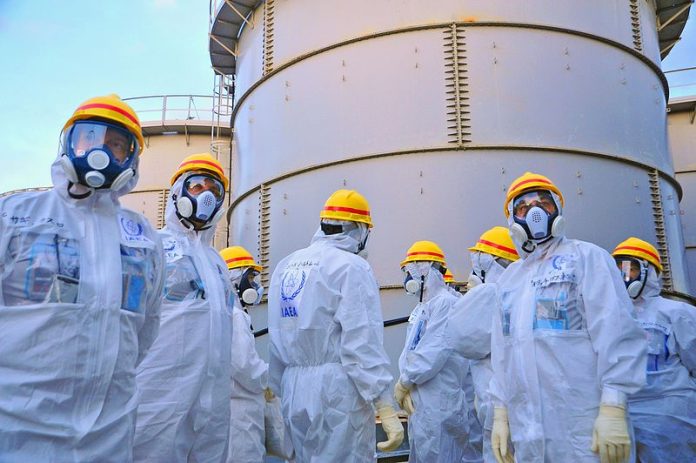International Atomic Energy Agency (IAEA) has confirmed that the tritium level in the fourth batch of diluted treated پانی, which Tokyo Electric Power Company (TEPCO) started discharging on 28 February 2024, is far below the Japan’s operational limit.
Experts stationed at the site of the Fukushima جوہری طاقت station (FDNPS) took samples after the treated پانی was diluted with سمندریٹر in the discharge facilities on 28 February. The analysis confirmed that the tritium concentration is far below the operational limit of 1,500 becquerels per litre.
Japan is discharging the treated پانی from the FDNPS in batches. The previous three batches – a total of 23,400 cubic metres of پانی – were also confirmed by the IAEA to have contained tritium concentrations far below operational limits.
Since the accident in 2011, پانی is needed to continually cool the melted fuel and fuel debris at the Fukushima Daiichi NPS. In addition to the پانی pumped in for this purpose, groundwater also seeps into the site from the surrounding environment, and rainwater falls into the damaged reactor and turbine buildings. When پانی comes in contact with melted fuel, fuel debris and other radioactive substances, it becomes contaminated.
The contaminated پانی is treated through a filtration process known as Advanced Liquid Processing System (ALPS) which uses a series of chemical reactions to remove 62 radionuclides from contaminated water before being stored. However, tritium cannot be from the contaminated water through ALPS. Tritium can be recovered when it is highly concentrated in small amounts of water, for example at جوہری fusion facilities. However, the stored water at the Fukushima Daiichi NPS has a low concentration of tritium in a large volume of water and so the existing technologies are not applicable.
Tritium is a naturally occurring radioactive form of hydrogen (half-life 12.32 years) that is produced in the atmosphere when cosmic rays collide with air molecules and has the lowest radiological impact of all naturally occurring radionuclides in seawater. Tritium is also a by-product of operating جوہری power plants to produce electricity. It emits weak beta-particles, i.e., electrons, with an average energy of 5.7 keV (kiloelectron-volts), which can penetrate about 6.0 mm of air but cannot penetrate the body through human skin. It may present a radiation hazard if inhaled or ingested but is only harmful to humans in very large doses.
Currently, contaminated water produced at the Fukushima Daiichi NPS is treated and stored on site in specially prepared tanks. TEPCO, the plant operator, has installed roughly 1000 of these tanks at the Fukushima Daiichi NPS site to hold around 1.3 million cubic meters of the treated water (as of 2 June 2022). Since 2011, the volume of water in storage has increased steadily, and the current tank خلائی available to store this water is nearing full capacity.
اگرچہ آلودہ پانی کی پیداوار کی شرح کو نمایاں طور پر کم کرنے کے لیے بہتری لائی گئی ہے، TEPCO نے اس بات کا تعین کیا ہے کہ اس جگہ کو مستقل طور پر ختم کرنے کو یقینی بنانے میں مدد کے لیے ایک طویل مدتی ڈسپوزل حل کی ضرورت ہے۔ اپریل 2021 میں، حکومت جاپان نے اپنی بنیادی پالیسی جاری کی جس میں ALPS سے علاج شدہ پانی کو سمندر میں کنٹرول شدہ اخراج کے ذریعے ٹھکانے لگانے کی سمت کا خاکہ پیش کیا گیا جو کہ گھریلو ریگولیٹری منظوری سے مشروط تقریباً 2 سالوں میں شروع کیا جائے گا۔
On 11 March 2011, Japan was shaken by the Great East Japan (Tohoku) زلزلہ. It was followed by a tsunami which resulted in waves reaching heights of more than 10 meters. The زلزلے and tsunami led to a major accident at the Fukushima Daiichi جوہری Power Station, which was ultimately categorized as a Level 7 on the International جوہری and Radiological Event Scale, the same level as the 1986 Chernobyl حادثے تاہم فوکوشیما میں صحت عامہ کے نتائج بہت کم سنگین ہیں۔
***
ذرائع کے مطابق:
- آئی اے ای اے پریس ریلیز – ALPS ٹریٹڈ واٹر کے چوتھے بیچ میں ٹریٹیم کی سطح جاپان کی آپریشنل حد سے بہت نیچے ہے، IAEA نے تصدیق کی۔ 29 فروری 2024 کو پوسٹ کیا گیا۔ https://www.iaea.org/newscenter/pressreleases/tritium-level-far-below-japans-operational-limit-in-fourth-batch-of-alps-treated-water-iaea-confirms
- آئی اے ای اے فوکوشیما ڈائیچی ALPS ٹریٹڈ واٹر ڈسچارج۔ ایڈوانسڈ مائع پروسیسنگ سسٹم (ALPS)۔ https://www.iaea.org/topics/response/fukushima-daiichi-nuclear-accident/fukushima-daiichi-alps-treated-water-discharge
- آئی اے ای اے فوکوشیما ڈائیچی ایٹمی حادثہ https://www.iaea.org/topics/response/fukushima-daiichi-nuclear-accident
***






































